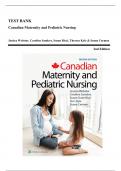Exam (elaborations)
Test Bank - Canadian Maternity and Pediatric Nursing, 2nd Edition (Webster, 2020), Chapter 1-51 | All Chapters
- Course
- Institution
- Book
Test Bank - Canadian Maternity and Pediatric Nursing, 2nd Edition (Webster, 2020), Chapter 1-51 | All Chapters
[Show more]



